 Facebook
Facebook
 X
X
 Instagram
Instagram
 TikTok
TikTok
 Youtube
Youtube

“For my 50th birthday, I bought myself a gutter,” quips Janet Lancaster of Clairemont. She’s talking about a rain gutter, that is — the one that Lancaster and her husband Kelly installed on their roof to collect rainwater they use for irrigation. But not a drop goes to watering the front lawn because, for the past two years, the Lancasters haven’t grown a blade of grass in front of their house on Boxford Drive. As it turns out, they’re part of a local trend: locals who willfully kill lawns and replace them with edibles.
In San Diego, as in most parts of the country, an emerald-green lawn — uniform, lush, free from crabgrass, dandelions, brown patches, and other meddlesome irregularities — has long been deemed a marker of suburban success, or at least middle-class conformity. But a certain number of locals have decided to uproot their lawns in favor of food gardens, replacing the real estate salesman’s vision with a more agrarian and utilitarian one.
The Lancasters’ first foray into the world of “food not lawns” occurred in May 2009, when Janet took a course called “Goodbye Grass” (or, as she jokes, “How to Kill Your Lawn”), the first in a series of six weekend classes taught at the (then) Quail Botanical Gardens in Encinitas. As she recalls: “I’d followed the Victory Gardens San Diego website for a while, and Kelly and I had talked about it.” Kelly adds, “Around the time the city [of San Diego] announced all the water restrictions, we thought we could pitch in.”
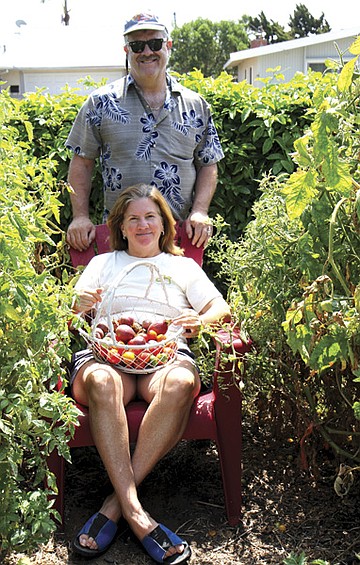
Their house, like most of the others on the street, is an early ’60s vintage tract home. One story, it sits on a small lot in a slightly dilapidated area off Balboa Avenue, near the 805, not far from the used-car lots and strip malls that festoon San Diego’s mesas. In times past, it might’ve been termed a working-class neighborhood — not poor, but a little down at the mouth. So there seemed a bit of unselfconscious irony that, by the time the planting had wrapped up, the once-prosaic front yard would yield some rather trendy produce, including passion fruit.
Passion fruit in San Diego? Isn’t that the expensive Hawaiian import rarely seen around these parts except at places like Whole Foods? Well, the Lancasters have an entire specialty-produce section of them: the hedge abutting the street is 20 feet long, five feet high, and filled with shiny, smooth, dappled-green fruit roughly the size and shape of avocados on diets. In a couple of months, they’ll turn black and wrinkled; Kelly says, “When they drop to the ground, they’re ripe.”
Like many in the lawn-to-food set, the Lancasters have tapped into a loosely knit network of local not-for-profit groups whose emphases center around the notion of small-scale food production. Spearheading things locally are San Diego Food Not Lawns and Victory Gardens San Diego, both of which are sponsored in part by the San Diego Roots Sustainable Food Project, a grant-funded mélange of private and public sector actors. Started in 2006, Food Not Lawns describes itself as a “food justice organization committed to enlightening people about the problems with our food system and working to address those problems with creative solutions.” I asked one of the organization’s board members, Phillip Dunn: “What the heck is ‘food justice?’” He replied, “It has to do with providing wider access to good, healthy food, and advocating that grocery stores locate in low-income areas. It’s also pushing to streamline the neighborhood garden permit process.”
Notwithstanding lofty ambitions to effectuate “justice,” many San Diegans with whom I spoke are motivated not only by environmental concerns, but by the desire to cut water bills; access to cheap, ultra-fresh, organic produce is also high on the list, as is the simple pleasure of watching things grow, and the old gardening standbys of exercise and relaxation.
I asked Janet Lancaster what led them to make the change. “I guess you could call me a tree-hugger. I’m concerned about the planet.”
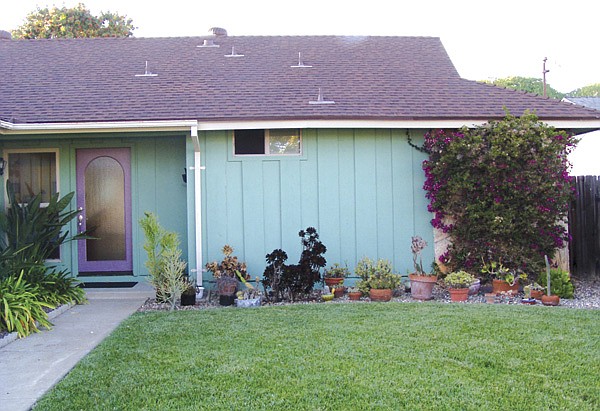
Whatever drives one to uproot a perfectly healthy patch of lawn in favor of bushes, vines, hedges, or small trees, it doesn’t hurt to have a green thumb or two. According to Bob Greenamyer, director of Victory Gardens, the latter attribute can be learned. (Lancaster claims to have a “brown thumb.”)
The Lancasters had planned to remove the grass in time for a fall “build,” Victory Garden argot for prepping a plot prior to planting. However, killing a lawn, in the environmentally gentle method preferred by the lawn-to-food folks, turned out to be more labor-intensive and time-consuming than they initially thought. “First, we starved it of water for three weeks,” Janet said. “Then, Kelly scalped it, mowed it as short as he could.” At that juncture, they were joined by a band of fellow turf-busters who helped them gather cardboard bicycle boxes they’d found behind stores in Pacific Beach. “We flattened out the boxes, took off all the tape and staples, spread them over the grass, and sprayed them with ten gallons of plain white vinegar.” Waiting in the wings was a 14-cubic-yard truckload of mulch, free from a local nursery, $100 to truck to the yard. This yielded a layer six inches deep over the 900-square-foot yard, which they again soaked with water. To allow the cardboard to break down sufficiently, they would need to give it more time and rain. “We spoke to a ‘master composter,’ who said we’d have to let it overwinter.”
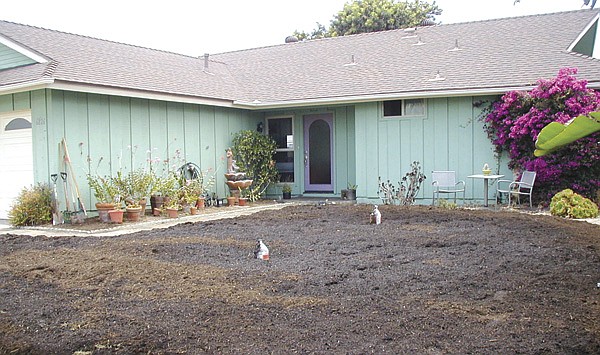
By May 2009, the fescue was doomed, and the second part of the build was on. As they had the prior spring, a group of Victory Gardens volunteers converged. It was now time to build a raised bed, to turn the soil, remove the last vestiges of intact cardboard, and amend the growing medium with gypsum. Using handmade, rectangular screens fashioned from old lumber and chicken wire, they removed rocks and roots. By the end of the day, arugula, carrots, chives, green rhubarb, lima beans, radishes, snap peas, squash, and tomatoes luxuriated where grass had once gulped water.
It’s the voracious thirst of turf that sets off those who uproot grass in favor of grub. The anti-grass gospel centers around the inefficiency of cultivating an inedible crop — turf — in a climate that can’t support it year-round without irrigation. Janet Lancaster, who claims significant water savings since removing the front lawn, quips, “Grass is pointless. Brown grass is really pointless.”
By the time I visited the house on Boxford, the Lancasters were celebrating their second summer of harvests. As he showed me around the yard, Kelly referred to a succession of plants as “volunteers.” I didn’t understand at first. Pointing at a sprawling tomato bush as tall as my head, he explained, “We didn’t plant that one — it’s a ‘volunteer.’ When I made compost, a few seeds got through and grew on their own.” Volunteer or conscript, he’s not perturbed by the imminent bumper crop. “I could eat tomatoes for breakfast, lunch, and dinner.”
Perhaps the most striking aspects of the Lancasters’ lawn conversion aren’t the edible, but the accoutrements and methodologies in place. Take worm “castings,” for example; not only do these folks buy and propagate earthworms for their garden, but they harvest the invertebrates’ feces by collecting waste after it falls through the holes in the plastic worm boxes. “We make worm tea. It’s great for controlling pests. We take the castings, put them in a balled-up pantyhose and soak it in water. Then we spray the plants.”
The Lancasters also go to great lengths to conserve and recycle water. Kelly shows me a hand-printed roster of units and dollars expended via their bi-monthly water bill from the City of San Diego. It shows a 30 percent or so reduction from summer’s peak-season usage in 2008 to 2010 (numbers from 2011 are pending).
To increase water savings, they’ve harvested rainwater and recycled gray water. Here’s where the rain gutters (“the good ones, $1000 — seamless,” says Janet) come in, feeding six 55-gallon polyethylene drums that sit below. The drums, four at each corner of the house, are brick-red numbers inscribed in Greek and Italian. Vaguely amphora-shaped, they’re European, imported via the internet at $110 a pop. Between each gutter-spout and the drum is an old tube sock that serves as a filter. Kelly says the water, which they use to irrigate their edible crops, is good enough to drink, better than San Diego tap water, at any rate. Gray water, on the other hand, water recycled from their washing machine via a hole drilled in the wall, is used for ornamentals and for flushing toilets. It’s low tech: the water splashes into a big plastic trash can, and from there, it’s poured into smaller buckets that once held kitty litter for their cat Boots.
I visited Bob Greenamyer’s personal victory garden on a mild, sun-splashed afternoon in May. At first glance, there’s nothing about his front yard that stands out, nothing that says, “I’m an anomaly in Scripps Ranch.” It’s subtle, perhaps even elegant, in an understated fashion, with lavender in bloom, miniature citrus trees and drought-resistant shrubs; there’s also a cadre of blue-green artichoke plants, some with nascent, spiky globes. But what’s radical, at least for this neck of San Diego’s woods, is what’s not here — grass. Greenamyer (with a name like that, he quips, his avocation “just had to be”) doesn’t have the smallest patch of Bermuda or rye in his back yard, although there is a rather incongruous-seeming artificial-turf putting green.
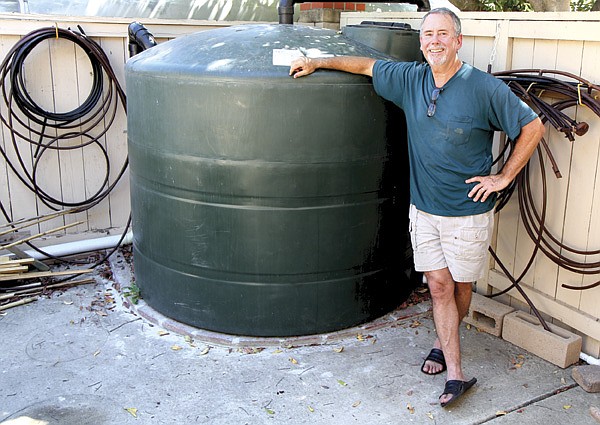
After the retired elementary school principal shows me around a bit more, the plastic grass starts to make sense, not in terms of aesthetics, but as evidence of the water-conservation tie-in that many lawn-eschewers promote. Collecting and impounding rainwater, and using it in sparing fashion, are at the heart of Greenamyer’s approach. He admits that for the majority of lawn-to-garden converts, his irrigation setup would be impractical, as it entails two water storage tanks, 1000 and 700 gallons, which are filled with water directed by the rain gutters on his roof. At a cost of around $2000 for the system, it wouldn’t be possible to recoup the investment unless “the utilities were to charge the real rate for water.”
Other home-food gardeners with whom I spoke claim that one needn’t spend exorbitant sums to save modest amounts. In the case of the Lancasters, total expenditures on behalf of a front-yard installation, including the complementary water-harvesting/recycling system, have amounted to around $2000. Accordingly, with water usage cut in half, they’re no more than a couple of years away from breaking even, not counting savings accrued by limiting store-bought produce. (For the record, Janet Lancaster admits to having paid landscapers around $8000 less than a decade ago to have Marathon fescue turf and a pop-up sprinkler system put in.)
Greenamyer, who converted his lawn in 2008, and other lawn-to-food advocates say that the lawn-conversion trend in San Diego County has also been spurred by the “slow food” movement. “People are more concerned these days not only about healthy eating, but about where their food comes from. There’s a focus on eating locally and seasonally.” According to home-farming fans, eating what’s grown nearby is not only better for the palate, but, in the economic scheme of things, the most sensible and efficient method for getting produce from the ground to the consumer. Greenamyer says: “San Diego has the largest number of small farms in the state, and California has the largest number of small farms in the U.S. But 95 percent of the production goes out of California, while 95 percent of what we consume here is imported from other states and countries.”
Eric Chamberlin, a librarian who’s in the process of transforming his “crunchy and brown” front lawn to food, doesn’t like those numbers at all. “Every bite of food we eat has traveled an average of 1000 miles.” Being self-sufficient is “a matter of long-term survival…because we’re running out of oil.” Last year, Eric and his wife Ingrid bought a run-down but spacious foreclosure property in East Oak Park, near the College Grove shopping center. For the Chamberlins, fruits and vegetables are just the beginning, the first phase of an “overall lifestyle change” that will eventually include raising pygmy goats for milk. (They plan to petition the City of San Diego for permission to keep the goats on the property.)
Every San Diegan lawn-to-food devotee I met to one extent or another views water conservation and recycling, along with organic farming practices, as an integral part of the movement. That’s not to say that they’re all community activists of the “Birkenstocks and bikes” mode. When I meet Charles Anacker at his rambling hillside lot in La Mesa, he is wearing a T-shirt bearing a Food Justice logo. He says, “I just liked the design. I’m not into the political stuff. You don’t have to be a leftist to do this. All kinds of people are interested, maybe even a few Christian fundamentalists.” For some, like Judith Griffith, 68, labels are irrelevant. Griffith, who recruited her grandsons to build a gopher-proof battery of four raised beds in her heretofore crabgrass-infested front lawn, says, “I have always been what is called ‘organic’; to us, it was just ‘natural.’”
According to Mel Lions, founder and board member at the San Diego Roots Sustainable Food Project, lawn-to-food locals are “limited to those people who eat food.” When I asked him if certain ideologies or demographics typify the trend, he replied, “It’s broad-based. Who doesn’t like fresh produce that you eat the moment it’s picked? There’s also satisfaction in knowing the history of your food.” Lions says it’s not mandatory to despise lawns. “They have a place. You can’t play baseball in a vegetable garden, for example. And a lawn is a nice place to play with your infant. But they shouldn’t be the dominant culture. The [lawn-to-food] movement isn’t so much a reaction against something as it is a proaction in favor of something else. Years ago, it was the norm to have a vegetable garden at home. We’re just going back to that.” He also touts the home-cultivation of edibles as a superior form of exercise. “Some people go to the gym and pay to use a treadmill. What do they get out of that? Nuthin’. But when you go out to your garden, you get fresh air, exercise, and a basket full of produce.”
Many San Diegans who’ve done the heretofore unthinkable plow-over of sacred turf got their know-how at one of the county’s five regional garden centers. Established under the grant, they’re located in a mix of urban and rural settings: City Heights, Encinitas, National City, South San Diego, and Spring Valley. According to Greenamyer, these “garden ed” classes fill up fast. “The demand is greater than the supply.” Even laconic Bob exults, “Interest is huge.”
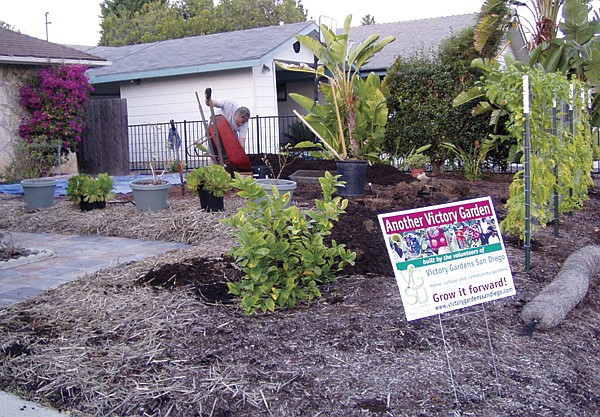
San Diego offers a copacetic venue for the front (or back) yard farmer. Our benign climate gets high marks. Greenamyer says, “We have a Mediterranean climate here, so we can grow just about anything.” Given the breadth of his own plantings, it’s an accurate assessment. To wit: one part of the yard has rows of raised containers hosting beets, cherry tomatoes, onions, snap peas, zucchini squash, and a plethora of herbs. Another patch is given over to fruit trees, varieties of apples, apricots, and others that skirt the usual winter “chill hour” needs. There’s also a section dedicated to citrus, a gathering of red grapes staked to the side-yard fence, and near the back property line, edible nasturtium flowers.
Is the effort worth it? Even if one can harvest quantifiable (albeit modest) savings in the form of lower water bills, does it make economic sense to uproot a lawn and replace it with veggies? When I asked Greenamyer whether lawn conversions result in lower food costs for the home-grower, he was equivocal. “It depends on how you value your time.”
There’s a lot to learn after you’ve yanked the last stubborn plug of Bermuda grass. To that end, it’s imperative to educate yourself about sites and soils, micro-climates and drainage, the kinds of details that standard-issue, HOA-friendly lawns don’t bring into play. Among these factors, soil composition is deemed to be the most critical; the county’s predominant clay is reviled. Janet Lancaster declares, “We have the best growing conditions and the worst soil.”
If it’s soil quality (or lack thereof) that serves as a common lament, it’s the art of composting that offers earthly salvation. For the uninitiated, the manufacture of compost would seem no more involved than a simple tossing of “stuff” into a container and standing by for rot, but to La Mesa’s Charles Anacker, it’s an art.
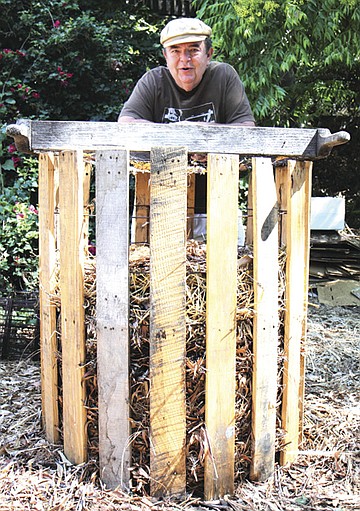
I met Anacker on the steep driveway that snakes up his ramshackle hillside lot. Fresh on the heels of taking a master composting class, he talked about the joys of decomposition. He walked over to a series of barrels and dug his hands into the rich, near-black admixture he’d created. “Feel this. It’s amazing how hot it gets in there, up to 150 degrees.” It was hot, all right — and it smelled a little like old coffee grounds, courtesy of Starbucks’ “grounds for gardens” program. Next, he directed my attention to a pile of cut eucalyptus logs and spoke about “hugelkultur,” the creation of raised soil beds by burying rotten wood.
Anacker, a furniture designer by trade, recalls that when he and his wife moved to La Mesa in 1990, they “inherited a large front yard, an old gas mower, and lots of gophers.” Never a turf fan, Anacker says he “gave the mower to a local gardener and decided to dedicate my large front yard to becoming a meadow and natural habitat. I didn’t know where this was going to lead, but I knew I didn’t want to poison my soil with chemical fertilizers, poisons to kill the gophers, or sprays to control insect pests. We planted a few fruit trees and allowed the skunks, rabbits, coyotes, opossums, raccoons, foxes, black birds, field mice, and Mexican parrots to call our front yard home.”
The Anackers’ first, tenuous efforts at creating a food garden failed; because they were unwilling to sacrifice the shade provided by rapidly spreading trees, the first plants died. Nowadays, with some of the big eucalyptus felled, you’ll find cherimoya, guava (both standard and “pineapple” varieties), kumquat, orange, and quince trees. On another section formerly devoted to Bermuda grass (which Anacker alternately praises and curses for its tenuous rhizomes), he’s crafted two 19 x 12 plots. One of the pest-fenced gardens has three raised beds planted with bell peppers, spinach, and tomatoes. The other’s going to be dedicated to fava beans, primarily so that Anacker can use the greens to enrich the soil for a future, still-undetermined crop. “After we eat the beans, I’m going to cut up the rest of the plant material as a nitrogen-fixing mulch.”
Whatever they end up planting in lieu of grass, San Diego area lawn-converters take the position that lawns are unnatural environments. Turf is a lousy way to use water, they claim, citing government-compiled water-usage statistics: e.g., lawns drink 270 billion gallons of water per week, enough to irrigate 327,000 square kilometers of organic vegetables. (According to the National Aeronautics and Space Administration, satellite and aerial imagery revealed, as of 2007, that around 162,000 square kilometers of the United States is given over to turf — three times the acreage dedicated to any single irrigated food crop.) In addition to water conservation, many in the lawn-to-garden movement link their efforts to larger environmental concerns; they say that the heavy use of herbicides and pesticides make traditional lawns a damaging choice.
Whatever large-scale environmental advantages there are to growing your own, foodies have gotten into the act. On its website, Slow Food Urban San Diego states that it “…links the pleasure of food with a commitment to the community and the environment.” The group, which labels itself a local chapter of Slow Food USA, describes its mission as “raising public awareness, improving access and encouraging the enjoyment of foods that are local, seasonal, and sustainably grown.”
All the local advocacy groups urge San Diegans to support farmers’ markets. But the question arises: If it’s convenient enough to buy produce at a farmers’ market, why grow your own at home? Even if there isn’t a homeowners’ association to set up hurdles, and even if the neighbors are supportive, is it worth the expenditure of time and effort? According to the Lancasters, it is, especially in the case of vegetables grown from seed. “Seeds are cheap.” By contrast, “starts,” or young plants, often run $5 or more apiece; depending on germination rates, a $1 package of seeds can yield dozens of plants. (Mel Lions says that one can save more money by not driving to a farmers’ market.)
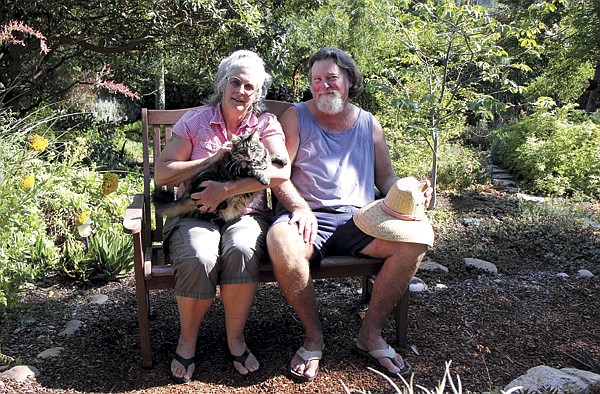
When pressed, San Diego’s lawn-to-food folks admit that saving money isn’t paramount. Maveh, a 50ish, tattooed retiree who lives with her husband Joe in Spring Valley, says, “I don’t care. It’s the joy I get from buying plants and watching them grow. I’d rather go to City Farmers Nursery on Euclid and spend $100 on plants than on a skirt at Nordstrom.” She exults in her distaste for turf. “I’m really anti-lawn. I’m glad the lawn is dead.”
Though not far from the 94 freeway, it isn’t easy to find Maveh and Joe’s place. Maybe it’s the narrow, winding Spring Valley streets, holdovers from faded ruritania. In front, there’s a small, intact lawn under the shade of gnarled pepper trees. The house itself feels reminiscent of something in Marin or Mendocino. What led them to remove their back lawn? Maveh explains, “After I took a class on xeriscape gardening, I became fascinated. I was never much of a lawn fan to begin with. It’s important to have a diversity of plants, especially native species, to avoid a monoculture. “
As I chatted with the affable pair, whose demeanor bespoke a certain counterculture holdover from the 1970s, I asked: “Did you have any gardening experience before you took out your lawn?” Maveh laughed and pointed to Joe, who is shambling, bearded, low-key. He fessed up to three decades’ worth of grounds-maintenance management at San Diego’s Park and Recreation Department.
When I saw the remains of their former backyard lawn, I understood: the place looks like a miniature botanical garden, a mixture of edibles and ornamentals set amid winding pathways, and hardly the work of casual hobbyists. Although the leitmotif here is “drought resistance,” it’s far from austere; in fact, for inland San Diego, it’s downright lush.
Not everything is edible. There are quirky things such as a spiky floss silk tree (which now and then goes by the colloquial “wife beater”), a tall honeysuckle hedge for privacy, and a Japanese pagoda tree that creates a shade canopy. There are stone fruit trees — Santa Rosa plum and dwarf nectarine — whose low chill hour requirements make them viable here, as well as cherimoya and quince. On the ground, they’ve planted native California strawberries and elderberries, and in containers, bell peppers, chives, cucumbers, tomatoes, and watermelons. Herbs — which epitomize small-scale, dry-climate gardening — may be the culinary stars: invited to sample, I squeezed a sprig of pungently aromatic lemon verbena, then tried a tiny bite of stevia, an in-vogue sugar substitute. Maveh said, “It’s almost too sweet,” but I enjoyed it.


“For my 50th birthday, I bought myself a gutter,” quips Janet Lancaster of Clairemont. She’s talking about a rain gutter, that is — the one that Lancaster and her husband Kelly installed on their roof to collect rainwater they use for irrigation. But not a drop goes to watering the front lawn because, for the past two years, the Lancasters haven’t grown a blade of grass in front of their house on Boxford Drive. As it turns out, they’re part of a local trend: locals who willfully kill lawns and replace them with edibles.
In San Diego, as in most parts of the country, an emerald-green lawn — uniform, lush, free from crabgrass, dandelions, brown patches, and other meddlesome irregularities — has long been deemed a marker of suburban success, or at least middle-class conformity. But a certain number of locals have decided to uproot their lawns in favor of food gardens, replacing the real estate salesman’s vision with a more agrarian and utilitarian one.
The Lancasters’ first foray into the world of “food not lawns” occurred in May 2009, when Janet took a course called “Goodbye Grass” (or, as she jokes, “How to Kill Your Lawn”), the first in a series of six weekend classes taught at the (then) Quail Botanical Gardens in Encinitas. As she recalls: “I’d followed the Victory Gardens San Diego website for a while, and Kelly and I had talked about it.” Kelly adds, “Around the time the city [of San Diego] announced all the water restrictions, we thought we could pitch in.”

Their house, like most of the others on the street, is an early ’60s vintage tract home. One story, it sits on a small lot in a slightly dilapidated area off Balboa Avenue, near the 805, not far from the used-car lots and strip malls that festoon San Diego’s mesas. In times past, it might’ve been termed a working-class neighborhood — not poor, but a little down at the mouth. So there seemed a bit of unselfconscious irony that, by the time the planting had wrapped up, the once-prosaic front yard would yield some rather trendy produce, including passion fruit.
Passion fruit in San Diego? Isn’t that the expensive Hawaiian import rarely seen around these parts except at places like Whole Foods? Well, the Lancasters have an entire specialty-produce section of them: the hedge abutting the street is 20 feet long, five feet high, and filled with shiny, smooth, dappled-green fruit roughly the size and shape of avocados on diets. In a couple of months, they’ll turn black and wrinkled; Kelly says, “When they drop to the ground, they’re ripe.”
Like many in the lawn-to-food set, the Lancasters have tapped into a loosely knit network of local not-for-profit groups whose emphases center around the notion of small-scale food production. Spearheading things locally are San Diego Food Not Lawns and Victory Gardens San Diego, both of which are sponsored in part by the San Diego Roots Sustainable Food Project, a grant-funded mélange of private and public sector actors. Started in 2006, Food Not Lawns describes itself as a “food justice organization committed to enlightening people about the problems with our food system and working to address those problems with creative solutions.” I asked one of the organization’s board members, Phillip Dunn: “What the heck is ‘food justice?’” He replied, “It has to do with providing wider access to good, healthy food, and advocating that grocery stores locate in low-income areas. It’s also pushing to streamline the neighborhood garden permit process.”
Notwithstanding lofty ambitions to effectuate “justice,” many San Diegans with whom I spoke are motivated not only by environmental concerns, but by the desire to cut water bills; access to cheap, ultra-fresh, organic produce is also high on the list, as is the simple pleasure of watching things grow, and the old gardening standbys of exercise and relaxation.
I asked Janet Lancaster what led them to make the change. “I guess you could call me a tree-hugger. I’m concerned about the planet.”

Whatever drives one to uproot a perfectly healthy patch of lawn in favor of bushes, vines, hedges, or small trees, it doesn’t hurt to have a green thumb or two. According to Bob Greenamyer, director of Victory Gardens, the latter attribute can be learned. (Lancaster claims to have a “brown thumb.”)
The Lancasters had planned to remove the grass in time for a fall “build,” Victory Garden argot for prepping a plot prior to planting. However, killing a lawn, in the environmentally gentle method preferred by the lawn-to-food folks, turned out to be more labor-intensive and time-consuming than they initially thought. “First, we starved it of water for three weeks,” Janet said. “Then, Kelly scalped it, mowed it as short as he could.” At that juncture, they were joined by a band of fellow turf-busters who helped them gather cardboard bicycle boxes they’d found behind stores in Pacific Beach. “We flattened out the boxes, took off all the tape and staples, spread them over the grass, and sprayed them with ten gallons of plain white vinegar.” Waiting in the wings was a 14-cubic-yard truckload of mulch, free from a local nursery, $100 to truck to the yard. This yielded a layer six inches deep over the 900-square-foot yard, which they again soaked with water. To allow the cardboard to break down sufficiently, they would need to give it more time and rain. “We spoke to a ‘master composter,’ who said we’d have to let it overwinter.”

By May 2009, the fescue was doomed, and the second part of the build was on. As they had the prior spring, a group of Victory Gardens volunteers converged. It was now time to build a raised bed, to turn the soil, remove the last vestiges of intact cardboard, and amend the growing medium with gypsum. Using handmade, rectangular screens fashioned from old lumber and chicken wire, they removed rocks and roots. By the end of the day, arugula, carrots, chives, green rhubarb, lima beans, radishes, snap peas, squash, and tomatoes luxuriated where grass had once gulped water.
It’s the voracious thirst of turf that sets off those who uproot grass in favor of grub. The anti-grass gospel centers around the inefficiency of cultivating an inedible crop — turf — in a climate that can’t support it year-round without irrigation. Janet Lancaster, who claims significant water savings since removing the front lawn, quips, “Grass is pointless. Brown grass is really pointless.”
By the time I visited the house on Boxford, the Lancasters were celebrating their second summer of harvests. As he showed me around the yard, Kelly referred to a succession of plants as “volunteers.” I didn’t understand at first. Pointing at a sprawling tomato bush as tall as my head, he explained, “We didn’t plant that one — it’s a ‘volunteer.’ When I made compost, a few seeds got through and grew on their own.” Volunteer or conscript, he’s not perturbed by the imminent bumper crop. “I could eat tomatoes for breakfast, lunch, and dinner.”
Perhaps the most striking aspects of the Lancasters’ lawn conversion aren’t the edible, but the accoutrements and methodologies in place. Take worm “castings,” for example; not only do these folks buy and propagate earthworms for their garden, but they harvest the invertebrates’ feces by collecting waste after it falls through the holes in the plastic worm boxes. “We make worm tea. It’s great for controlling pests. We take the castings, put them in a balled-up pantyhose and soak it in water. Then we spray the plants.”
The Lancasters also go to great lengths to conserve and recycle water. Kelly shows me a hand-printed roster of units and dollars expended via their bi-monthly water bill from the City of San Diego. It shows a 30 percent or so reduction from summer’s peak-season usage in 2008 to 2010 (numbers from 2011 are pending).
To increase water savings, they’ve harvested rainwater and recycled gray water. Here’s where the rain gutters (“the good ones, $1000 — seamless,” says Janet) come in, feeding six 55-gallon polyethylene drums that sit below. The drums, four at each corner of the house, are brick-red numbers inscribed in Greek and Italian. Vaguely amphora-shaped, they’re European, imported via the internet at $110 a pop. Between each gutter-spout and the drum is an old tube sock that serves as a filter. Kelly says the water, which they use to irrigate their edible crops, is good enough to drink, better than San Diego tap water, at any rate. Gray water, on the other hand, water recycled from their washing machine via a hole drilled in the wall, is used for ornamentals and for flushing toilets. It’s low tech: the water splashes into a big plastic trash can, and from there, it’s poured into smaller buckets that once held kitty litter for their cat Boots.
I visited Bob Greenamyer’s personal victory garden on a mild, sun-splashed afternoon in May. At first glance, there’s nothing about his front yard that stands out, nothing that says, “I’m an anomaly in Scripps Ranch.” It’s subtle, perhaps even elegant, in an understated fashion, with lavender in bloom, miniature citrus trees and drought-resistant shrubs; there’s also a cadre of blue-green artichoke plants, some with nascent, spiky globes. But what’s radical, at least for this neck of San Diego’s woods, is what’s not here — grass. Greenamyer (with a name like that, he quips, his avocation “just had to be”) doesn’t have the smallest patch of Bermuda or rye in his back yard, although there is a rather incongruous-seeming artificial-turf putting green.

After the retired elementary school principal shows me around a bit more, the plastic grass starts to make sense, not in terms of aesthetics, but as evidence of the water-conservation tie-in that many lawn-eschewers promote. Collecting and impounding rainwater, and using it in sparing fashion, are at the heart of Greenamyer’s approach. He admits that for the majority of lawn-to-garden converts, his irrigation setup would be impractical, as it entails two water storage tanks, 1000 and 700 gallons, which are filled with water directed by the rain gutters on his roof. At a cost of around $2000 for the system, it wouldn’t be possible to recoup the investment unless “the utilities were to charge the real rate for water.”
Other home-food gardeners with whom I spoke claim that one needn’t spend exorbitant sums to save modest amounts. In the case of the Lancasters, total expenditures on behalf of a front-yard installation, including the complementary water-harvesting/recycling system, have amounted to around $2000. Accordingly, with water usage cut in half, they’re no more than a couple of years away from breaking even, not counting savings accrued by limiting store-bought produce. (For the record, Janet Lancaster admits to having paid landscapers around $8000 less than a decade ago to have Marathon fescue turf and a pop-up sprinkler system put in.)
Greenamyer, who converted his lawn in 2008, and other lawn-to-food advocates say that the lawn-conversion trend in San Diego County has also been spurred by the “slow food” movement. “People are more concerned these days not only about healthy eating, but about where their food comes from. There’s a focus on eating locally and seasonally.” According to home-farming fans, eating what’s grown nearby is not only better for the palate, but, in the economic scheme of things, the most sensible and efficient method for getting produce from the ground to the consumer. Greenamyer says: “San Diego has the largest number of small farms in the state, and California has the largest number of small farms in the U.S. But 95 percent of the production goes out of California, while 95 percent of what we consume here is imported from other states and countries.”
Eric Chamberlin, a librarian who’s in the process of transforming his “crunchy and brown” front lawn to food, doesn’t like those numbers at all. “Every bite of food we eat has traveled an average of 1000 miles.” Being self-sufficient is “a matter of long-term survival…because we’re running out of oil.” Last year, Eric and his wife Ingrid bought a run-down but spacious foreclosure property in East Oak Park, near the College Grove shopping center. For the Chamberlins, fruits and vegetables are just the beginning, the first phase of an “overall lifestyle change” that will eventually include raising pygmy goats for milk. (They plan to petition the City of San Diego for permission to keep the goats on the property.)
Every San Diegan lawn-to-food devotee I met to one extent or another views water conservation and recycling, along with organic farming practices, as an integral part of the movement. That’s not to say that they’re all community activists of the “Birkenstocks and bikes” mode. When I meet Charles Anacker at his rambling hillside lot in La Mesa, he is wearing a T-shirt bearing a Food Justice logo. He says, “I just liked the design. I’m not into the political stuff. You don’t have to be a leftist to do this. All kinds of people are interested, maybe even a few Christian fundamentalists.” For some, like Judith Griffith, 68, labels are irrelevant. Griffith, who recruited her grandsons to build a gopher-proof battery of four raised beds in her heretofore crabgrass-infested front lawn, says, “I have always been what is called ‘organic’; to us, it was just ‘natural.’”
According to Mel Lions, founder and board member at the San Diego Roots Sustainable Food Project, lawn-to-food locals are “limited to those people who eat food.” When I asked him if certain ideologies or demographics typify the trend, he replied, “It’s broad-based. Who doesn’t like fresh produce that you eat the moment it’s picked? There’s also satisfaction in knowing the history of your food.” Lions says it’s not mandatory to despise lawns. “They have a place. You can’t play baseball in a vegetable garden, for example. And a lawn is a nice place to play with your infant. But they shouldn’t be the dominant culture. The [lawn-to-food] movement isn’t so much a reaction against something as it is a proaction in favor of something else. Years ago, it was the norm to have a vegetable garden at home. We’re just going back to that.” He also touts the home-cultivation of edibles as a superior form of exercise. “Some people go to the gym and pay to use a treadmill. What do they get out of that? Nuthin’. But when you go out to your garden, you get fresh air, exercise, and a basket full of produce.”
Many San Diegans who’ve done the heretofore unthinkable plow-over of sacred turf got their know-how at one of the county’s five regional garden centers. Established under the grant, they’re located in a mix of urban and rural settings: City Heights, Encinitas, National City, South San Diego, and Spring Valley. According to Greenamyer, these “garden ed” classes fill up fast. “The demand is greater than the supply.” Even laconic Bob exults, “Interest is huge.”

San Diego offers a copacetic venue for the front (or back) yard farmer. Our benign climate gets high marks. Greenamyer says, “We have a Mediterranean climate here, so we can grow just about anything.” Given the breadth of his own plantings, it’s an accurate assessment. To wit: one part of the yard has rows of raised containers hosting beets, cherry tomatoes, onions, snap peas, zucchini squash, and a plethora of herbs. Another patch is given over to fruit trees, varieties of apples, apricots, and others that skirt the usual winter “chill hour” needs. There’s also a section dedicated to citrus, a gathering of red grapes staked to the side-yard fence, and near the back property line, edible nasturtium flowers.
Is the effort worth it? Even if one can harvest quantifiable (albeit modest) savings in the form of lower water bills, does it make economic sense to uproot a lawn and replace it with veggies? When I asked Greenamyer whether lawn conversions result in lower food costs for the home-grower, he was equivocal. “It depends on how you value your time.”
There’s a lot to learn after you’ve yanked the last stubborn plug of Bermuda grass. To that end, it’s imperative to educate yourself about sites and soils, micro-climates and drainage, the kinds of details that standard-issue, HOA-friendly lawns don’t bring into play. Among these factors, soil composition is deemed to be the most critical; the county’s predominant clay is reviled. Janet Lancaster declares, “We have the best growing conditions and the worst soil.”
If it’s soil quality (or lack thereof) that serves as a common lament, it’s the art of composting that offers earthly salvation. For the uninitiated, the manufacture of compost would seem no more involved than a simple tossing of “stuff” into a container and standing by for rot, but to La Mesa’s Charles Anacker, it’s an art.

I met Anacker on the steep driveway that snakes up his ramshackle hillside lot. Fresh on the heels of taking a master composting class, he talked about the joys of decomposition. He walked over to a series of barrels and dug his hands into the rich, near-black admixture he’d created. “Feel this. It’s amazing how hot it gets in there, up to 150 degrees.” It was hot, all right — and it smelled a little like old coffee grounds, courtesy of Starbucks’ “grounds for gardens” program. Next, he directed my attention to a pile of cut eucalyptus logs and spoke about “hugelkultur,” the creation of raised soil beds by burying rotten wood.
Anacker, a furniture designer by trade, recalls that when he and his wife moved to La Mesa in 1990, they “inherited a large front yard, an old gas mower, and lots of gophers.” Never a turf fan, Anacker says he “gave the mower to a local gardener and decided to dedicate my large front yard to becoming a meadow and natural habitat. I didn’t know where this was going to lead, but I knew I didn’t want to poison my soil with chemical fertilizers, poisons to kill the gophers, or sprays to control insect pests. We planted a few fruit trees and allowed the skunks, rabbits, coyotes, opossums, raccoons, foxes, black birds, field mice, and Mexican parrots to call our front yard home.”
The Anackers’ first, tenuous efforts at creating a food garden failed; because they were unwilling to sacrifice the shade provided by rapidly spreading trees, the first plants died. Nowadays, with some of the big eucalyptus felled, you’ll find cherimoya, guava (both standard and “pineapple” varieties), kumquat, orange, and quince trees. On another section formerly devoted to Bermuda grass (which Anacker alternately praises and curses for its tenuous rhizomes), he’s crafted two 19 x 12 plots. One of the pest-fenced gardens has three raised beds planted with bell peppers, spinach, and tomatoes. The other’s going to be dedicated to fava beans, primarily so that Anacker can use the greens to enrich the soil for a future, still-undetermined crop. “After we eat the beans, I’m going to cut up the rest of the plant material as a nitrogen-fixing mulch.”
Whatever they end up planting in lieu of grass, San Diego area lawn-converters take the position that lawns are unnatural environments. Turf is a lousy way to use water, they claim, citing government-compiled water-usage statistics: e.g., lawns drink 270 billion gallons of water per week, enough to irrigate 327,000 square kilometers of organic vegetables. (According to the National Aeronautics and Space Administration, satellite and aerial imagery revealed, as of 2007, that around 162,000 square kilometers of the United States is given over to turf — three times the acreage dedicated to any single irrigated food crop.) In addition to water conservation, many in the lawn-to-garden movement link their efforts to larger environmental concerns; they say that the heavy use of herbicides and pesticides make traditional lawns a damaging choice.
Whatever large-scale environmental advantages there are to growing your own, foodies have gotten into the act. On its website, Slow Food Urban San Diego states that it “…links the pleasure of food with a commitment to the community and the environment.” The group, which labels itself a local chapter of Slow Food USA, describes its mission as “raising public awareness, improving access and encouraging the enjoyment of foods that are local, seasonal, and sustainably grown.”
All the local advocacy groups urge San Diegans to support farmers’ markets. But the question arises: If it’s convenient enough to buy produce at a farmers’ market, why grow your own at home? Even if there isn’t a homeowners’ association to set up hurdles, and even if the neighbors are supportive, is it worth the expenditure of time and effort? According to the Lancasters, it is, especially in the case of vegetables grown from seed. “Seeds are cheap.” By contrast, “starts,” or young plants, often run $5 or more apiece; depending on germination rates, a $1 package of seeds can yield dozens of plants. (Mel Lions says that one can save more money by not driving to a farmers’ market.)

When pressed, San Diego’s lawn-to-food folks admit that saving money isn’t paramount. Maveh, a 50ish, tattooed retiree who lives with her husband Joe in Spring Valley, says, “I don’t care. It’s the joy I get from buying plants and watching them grow. I’d rather go to City Farmers Nursery on Euclid and spend $100 on plants than on a skirt at Nordstrom.” She exults in her distaste for turf. “I’m really anti-lawn. I’m glad the lawn is dead.”
Though not far from the 94 freeway, it isn’t easy to find Maveh and Joe’s place. Maybe it’s the narrow, winding Spring Valley streets, holdovers from faded ruritania. In front, there’s a small, intact lawn under the shade of gnarled pepper trees. The house itself feels reminiscent of something in Marin or Mendocino. What led them to remove their back lawn? Maveh explains, “After I took a class on xeriscape gardening, I became fascinated. I was never much of a lawn fan to begin with. It’s important to have a diversity of plants, especially native species, to avoid a monoculture. “
As I chatted with the affable pair, whose demeanor bespoke a certain counterculture holdover from the 1970s, I asked: “Did you have any gardening experience before you took out your lawn?” Maveh laughed and pointed to Joe, who is shambling, bearded, low-key. He fessed up to three decades’ worth of grounds-maintenance management at San Diego’s Park and Recreation Department.
When I saw the remains of their former backyard lawn, I understood: the place looks like a miniature botanical garden, a mixture of edibles and ornamentals set amid winding pathways, and hardly the work of casual hobbyists. Although the leitmotif here is “drought resistance,” it’s far from austere; in fact, for inland San Diego, it’s downright lush.
Not everything is edible. There are quirky things such as a spiky floss silk tree (which now and then goes by the colloquial “wife beater”), a tall honeysuckle hedge for privacy, and a Japanese pagoda tree that creates a shade canopy. There are stone fruit trees — Santa Rosa plum and dwarf nectarine — whose low chill hour requirements make them viable here, as well as cherimoya and quince. On the ground, they’ve planted native California strawberries and elderberries, and in containers, bell peppers, chives, cucumbers, tomatoes, and watermelons. Herbs — which epitomize small-scale, dry-climate gardening — may be the culinary stars: invited to sample, I squeezed a sprig of pungently aromatic lemon verbena, then tried a tiny bite of stevia, an in-vogue sugar substitute. Maveh said, “It’s almost too sweet,” but I enjoyed it.
Comments